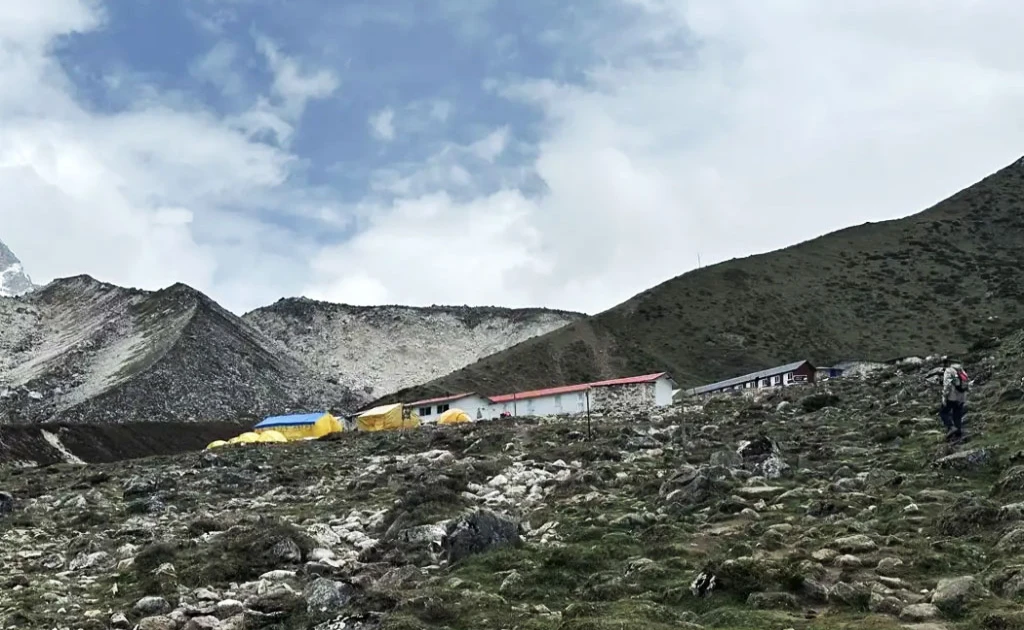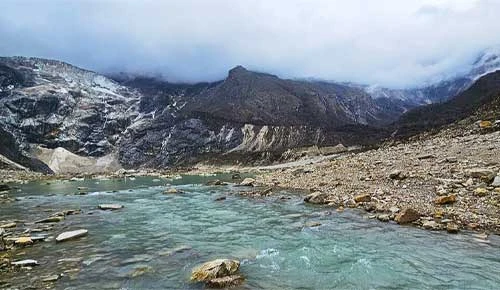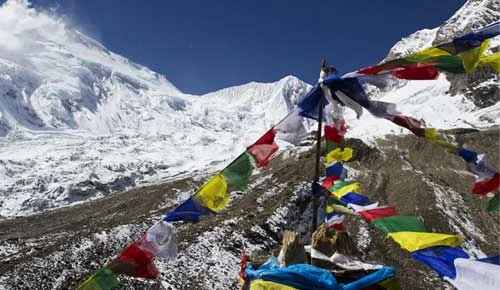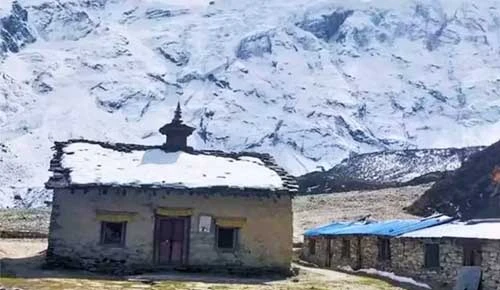Dharmashala Village Travel Guide
Dharamsala is a small village on the Manaslu Circuit Trek that is located at 1,860m; it is one of the lower-lying villages but an excellent place to experience the Tibetan culture and get a glimpse of the Himalayas. Top Churu is famous as a tranquility area with old stone houses and monasteries and mountain views. Dharamsala is an ideal place to rest and acclimatize and experience local life before moving up to Namrung and Namrung's higher villages.
The village is surrounded by pine and rhododendron forests, with tracks weaving through the hills and rivers. Trekkers who go through Dharamsala experience not just the tranquility but also get to know the villagers some and see daily village life steeped in Tibetan and Gurung ethnic cultures. Small streams, grazing yaks, and prayer flags in the area all add to the beauty of the village and make for great photo opportunities and cultural experiences.
Dharamsala is more than a dump and dinner place—it is also an area to see the physical and cultural differences as trekkers climb higher onto the Manaslu Circuit. You get a chance to see how folks in high-hill towns live. You observe this as you go from low-hill towns like Jagat to Dharamsala. You will pass through woods, step farms, and local settlements.
Best Time to Visit Dharamsala
Spring (March to May)
Spring can be perhaps the most rewarding time to travel to Dharamsala. Because of the mild temperatures, mostly clear skies, and blooming rhododendron forests, colors are vibrant and the views are excellent. Cheerful temperatures offer great conditions for walking and great acclimatization conditions for trekkers heading towards higher ascents along the Manaslu Circuit.
Autumn (September to November)
Autumn is frequently the "prime" trekking season in Dharamsala. The skies are clear after the monsoon. You can see Manaslu & nearby hills well. It takes your breath. It is warm. It makes it great for long walks in nice air. Also, villagers celebrate festivals in their traditional way. This lets hikers feel the real life up in the remote area.
Winter (December to February)
Winter in Dharamsala sees a drop in temperature, which at times includes snow. Only the experienced and well-equipped trekkers brave out this season. Although it is a tough go for them, the area does see a lot of peace and excellent Himalayan views.
Summer/Monsoon (June to August)
The monsoon season isn’t the best for trekking, which we see in heavy rain, slipperiness of the paths, and at times landslides. However, despite that, the region showcases a lush green landscape, and the lower trekking routes are significantly less crowded. This is the time for the adventurous trekkers who don’t mind the weather challenge and seek solitude.
How to Reach Dharamsala?
By Road (Bus/Private Jeep)
- The most common way is to drive from Kathmandu to Soti Khola, which usually takes 8–9 hours.
- The route passes through Dhading, Arughat, and several scenic towns along the Budhi Gandaki River.
- From Soti Khola, trekkers begin the Manaslu Circuit Trail, passing through Machha Khola, Jagat, and Deng before reaching Dharamsala.
- Private jeeps and buses are available, and overnight stops in Soti Khola are common to break the journey.
By Air (Domestic Flights)
- There are no direct flights to Dharamsala; the nearest domestic airstrips are Tribhuvan International Airport in Kathmandu (starting point) and Pokhara Airport, depending on trekking agency arrangements.
- Trekking usually begins from the road entry point (Soti Khola) rather than flying closer.
Accommodation and Food In Dharmasala
Dharamsala is a small, high-altitude village at which trekkers do not find luxury accommodation. But the local teahouses and lodges do offer comfortable and very authentic places to stop over on the way to complete the Manaslu Circuit trek. Most of the accommodations are very basic, stone-built lodges that have wooden rooms, twin-share mattresses and basic bedding. They also provide blankets, which is great, but nights can be very cold, so it is advised to bring your sleeping bag. Also expect communal toilets, and for hot showers, if they are provided, to be either a separate charge or supplied through solar heating or from a bucket system.
Food in Dharamsala is basic but filling, which we have put out for the use of trekkers that require energy for very long days of travel. The main dish is Dal Bhat—rice, lentils, veggies, and pickles—which you may help yourself to as much as you like and which also is a great energy source. Also you will find that we have lots of noodles, fried rice, soups and Tibetan bread. Into the mix we have the Tibetan cultural influence, which brings in local specialties like momos, thukpa and butter tea, which are a real hit in the cold weather.
While menu choices are few and prices are a bit higher, which is to compensate for the fact that supplies have to be brought in by porters or mules from the lower villages, the food is very nutritious, filling, and fresh. In Dharamsala, you have the cultural experience of sitting by a stove with other travelers, drinking butter tea, and watching the prayer flags wave outside. The warmth and hospitality of the villagers makes your stay in Dharamsala an exceptional thing, which goes beyond just rest and gives you a look into the local high-altitude life.
Major Attractions
- Dharmasala Village features traditional Tibetan-style stone houses reflecting local architecture.
- The village is home to serene Buddhist monasteries, mani walls, and colorful prayer flags.
- Visitors can enjoy panoramic views of Shringi Himal and surrounding Himalayan peaks.
- Yak pastures and alpine meadows provide a glimpse of high-altitude rural life.
- Forested trails with pine and rhododendron trees make for peaceful trekking paths.
- Local festivals, traditional ceremonies, and Tibetan cultural centers showcase the village’s rich heritage.
- Scenic viewpoints are perfect for capturing stunning sunrise and sunset photographs.
Things to Do in Dharmasala
Explore the Village Lanes
Taking a stroll through the lanes of Dharamsala is an easy but fulfilling task. The paths paved with stones turn along the old Tibetan houses so that you have an opportunity to see the architecture that has been able to resist hostile weather for centuries. People sit outside, usually weaving, taking care of animals, or drying grains and this could add some culture to your stroll. You will also get to see the interaction of the trekkers with the people in the villages, making the village come alive, though it is remote.
Visit Local Monasteries
There is no big monastery such as those at Samagaun or Lho, but the little gompas in Dharamsala are laden with great spiritual importance. Spending the time indoors provides you with a noisy rest after hiking. There are hundreds of monks chanting, you can smell the incense, and you can observe the rituals carried out in a classic manner. It is not only seen as a good thing to light a butter lamp here, but it also gives a sense of calmness and contemplation.
Spin the Prayer Wheels
You will find many walls and prayer wheels depicting Tibetan mantras along the paths and along village edges. Turning these wheels clockwise, repeating Om Mani Padme Hum, is a meditative practice, which is believed to propagate blessings. As a trekker, it provides a breather during the rigorous climbs. These holy walls too turn the surroundings colorful with carvings and paintings that are extremely visible on the snowy background of the mountains. It is both spiritual and cultural, and it offers you a greater connection to the land.
Taste Yak Butter Tea
Villages such as Dharamsala almost have a ritual of drinking the yak butter tea. The tea is prepared by churning butter and salt in black tea to produce a special taste quite unlike ordinary tea. Although initially this may not go down well with your taste buds, it is rich in calories and fat, which aids in keeping the body warm and active at high altitude.
Try Local Dishes
Dharamsala's food is simple yet filling, and eating local dishes is a unique way to experience the place. More than dal bhat, trekkers also enjoy thukpa (noodle soup), tingmo (bread), or momos (dumplings). These meals fill bellies but also show the Tibetans' influences from the highlands. Eating here is not about wealth but rather about good nourishment and traditions.
Observe Wildlife and Birds
The hills and meadows that surround the area provide a habitat for the birds of the Himalayas, such as the snow pigeon, choughs, and, at times, the national bird of Nepal, the Danphe. It is a good thing to see if you happen to be there, the Himalayan blue sheep feeding on the steep slope. The process of watching wildlife here is tranquil and demands perseverance; nonetheless, the treasures one receives are magnificent.
Available Packages
Nepal Trek Adventures is a reputable trekking outfit that offers guided professional services and the Manaslu Circuit, among others. Guided by professionals, local knowledge and a sense of safety mean that all trekkers will have a comfortable and adventurous experience with NTA. By selecting NTA, you are accompanied on your Himalayan expedition, including permits and logistics, local culture and high-altitude safety. Here are some packages:
- Manaslu Circuit Trek – 13 Days
- Manaslu Express Trekking – 10 Days
- Manaslu Tsum Valley Trekking
- Manaslu Circuit Luxury Trek
- Manaslu Base Camp Trekking
Final Words
Dharamsala is a tiny yet very significant stop on the Manaslu Circuit, which not only offers rest but also cultural experiences to the trekkers. It is enclosed by stone structures, monasteries and prayer walls and is an imitation of the real life of Himalayan communities. The facilities in the village are plain, yet the village is the dwelling place of warmth in terms of food, hospitality and spirituality. With beautiful views of the nearby mountain and shabby environment, Dharamsala becomes more than a place to rest; it is an essential place for the Manaslu expedition, where innocence, culture, and nature collide.




